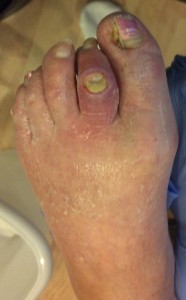Arterial ulcers
/ɑɹtɪɹiʌl/ /ʌlsɝz/
1. [noun] arterial ulcers, also referred to as ischemic ulcers , are caused by poor perfusion (delivery of nutrient-rich blood) to the lower extremities . The overlying skin and tissues are then deprived of oxygen, killing these tissues and causing the area to form an open wound. In addition, the lack of blood supply can result in minor scrapes or cuts failing to heal and eventually developing into ulcers . Distinguishing features of arterial ulcers include : Located on the lower legs and tops of the feet or toes A tendency to be painful, particularly at night A symmetrical shape with well-defined borders, often described as having a 'punched-out appearance' Minimal bleeding when touched or knocked Cool, pale or bluish surrounding skin that appears shiny Loss of leg hair Faint or absent ankle pulses. Other symptoms of arterial insufficiency may also be present, such as: Cramping pains in the buttocks and back of the legs during exercise, relieved by rest (intermittent claudication ); this is due to insufficient oxygen supply to meet the increased needs of exercising muscle Burning leg or foot pain at rest, which is relieved by lowering the foot and made worse by elevating it. The most common causes of arterial ulcers are: Restrictions to blood vessels due to peripheral vascular disease Chronic vascular insufficiency Vasculitis (inflammatory damage of blood vessels) Diabetes mellitus Renal failure High blood pressure Arteriosclerosis (hardening of the arteries) Atherosclerosis (thickening of the arteries, due to the buildup of fatty materials) Trauma Limited joint mobility Increased age Sources:
Source: https://www.woundsource.com/patientcondition/arterial-ulcers

Frequently Asked Questions
How can a 'punched-out' ulcer on the top of the foot signal circulation issues?
Noticing a well-defined, 'punched-out' sore with cool, pale skin and minimal bleeding can indicate reduced blood flow to the foot tissues, offering a clue about arterial limitations.
How might observing changes in foot skin and hair be linked to arterial health?
A loss of leg hair combined with shiny, pale skin on the foot often hints at impaired arterial circulation, as reduced oxygen-rich blood flow affects both skin appearance and hair growth.
How does nighttime foot pain provide insight into arterial-related issues?
Experiencing increased foot pain at night, when gravity no longer aids circulation, can be a sign of arterial concerns. This discomfort is often linked with diminished blood flow affecting foot tissues.